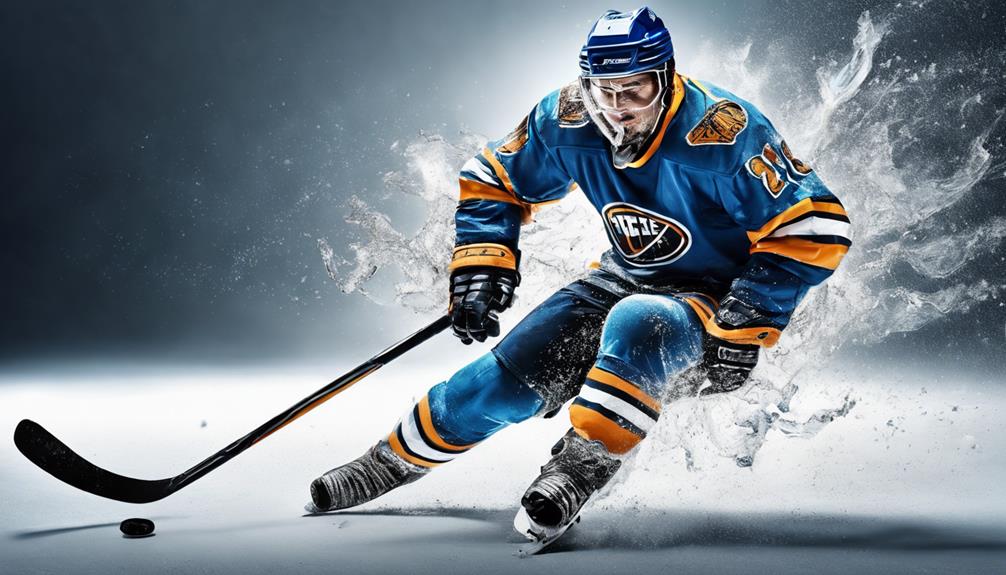The speed at which hockey players can skate is a topic of fascination and admiration among fans and analysts alike. From the thunderous strides of legendary players to the cutting-edge technology used to measure velocity, the quest to push the limits of human performance on ice continues to evolve.
As we explore the boundaries of speed in hockey, we uncover a world where precision, power, and technique converge to create a mesmerizing display of athleticism. But just how fast can these elite athletes truly go? Let's unravel the mysteries behind their lightning-quick movements and what sets them apart in the realm of professional sports.
Top Speeds Reached on Ice
When considering the top speeds reached by hockey players on ice, it is evident that their exceptional athleticism and skill play a significant role in achieving remarkable velocities. In comparison to Olympic sprinters and speed skaters, hockey players showcase impressive speed capabilities during gameplay.
While Olympic sprinters excel in straight-line sprints and speed skaters dominate in long-track events, hockey players exhibit a unique blend of agility, power, and speed on the ice. The dynamic nature of hockey requires players to accelerate, decelerate, and maneuver swiftly, making their speed achievements even more remarkable.
Factors Influencing Skating Velocity
Numerous key factors intricately influence the velocity at which hockey players can skate on the ice, encompassing a blend of physical attributes, technical skills, and strategic decision-making. When it comes to skating velocity, factors such as skating biomechanics and equipment advancements play a crucial role.
- Skating Biomechanics: Understanding how to efficiently use body movements, weight distribution, and stride length can significantly impact a player's speed on the ice.
- Equipment Advancements: Innovations in skate design, blade technology, and materials have improved players' ability to generate power and glide faster on the ice.
- Training Techniques: Utilizing specific drills, strength training, and conditioning programs tailored to enhance speed and agility can help players reach their maximum skating velocity potential.
Comparison of NHL Skaters' Speed
In examining the speed capabilities of NHL skaters, it becomes evident that the interplay between various factors like skating biomechanics, equipment advancements, and training techniques significantly influences their on-ice performance. Player rankings often serve as a benchmark for evaluating speed, with notable skaters consistently showcasing exceptional velocity.
Equipment advancements, such as lighter and more aerodynamic gear, contribute to minimizing drag and enhancing skaters' speed potential. The comparison of NHL skaters' speed is not merely a matter of individual talent but also reflects the synergy between the skater's technique and the gear they use.
Training Techniques for Speed Improvement
How can athletes enhance their speed through strategic training techniques that optimize their biomechanics and physical conditioning?
To improve speed in hockey players, a combination of off-ice drills and sprint techniques can be highly effective.
Incorporating muscle strength training into their regimen is crucial for generating the power needed for explosive speed on the ice.
Additionally, agility drills help players improve their directional changes and quickness, translating into faster movements during gameplay.
Speed Records in Professional Hockey
Given the continuous advancements in athletic performance and training techniques in hockey, professional players have been setting remarkable speed records, showcasing the pinnacle of velocity on the ice. Some have even rivaled Olympic speedsters with their lightning-fast sprints across the rink. These speed demons have not only broken previous records but have also etched their names into the prestigious Guinness Book records for their exceptional velocity.
From short bursts of acceleration to maintaining top speeds over extended distances, these players exemplify the epitome of speed in professional hockey. As technology and training methods continue to evolve, it is exciting to witness how these speed records will be pushed even further in the future, setting new benchmarks for generations to come.
Future Trends in Skating Velocity
With advancements in technology and training methods constantly pushing the boundaries of athletic performance, the future of skating velocity in professional hockey appears poised for unprecedented growth and innovation. As we look ahead, several key factors will shape the evolution of skating speed:
- Technology Advancements: Continued innovations in equipment design and performance tracking systems will provide players with invaluable insights to enhance their speed on the ice.
- Genetic Factors: Understanding the role of genetics in determining an athlete's physical attributes, including speed, will lead to tailored training programs for optimal performance.
- Physiological Limits: Exploring the physiological limits of the human body and implementing specialized training techniques will help players break through current speed barriers, setting new standards in skating velocity.
Frequently Asked Questions
How Do Different Types of Ice Surfaces Affect a Player's Skating Speed?
The type of ice surface can significantly impact a player's skating speed. Surface material and temperature influence blade friction, affecting acceleration and maneuverability. Blade design is crucial, with different edges and hollows tailored for optimal performance on varied ice conditions.
Are There Any Technological Advancements Being Made to Improve Hockey Players' Speed?
In the realm of hockey performance enhancement, cutting-edge training techniques along with sophisticated wearable technology have emerged. Biomechanical analysis and performance tracking tools are revolutionizing how players optimize their speed and agility on the ice.
Can a Player's Equipment, Such as Skates or Protective Gear, Impact Their Skating Velocity?
The material used in skates significantly impacts a player's performance on the ice. Lightweight and durable materials enhance speed and agility. Additionally, aerodynamic design in protective gear reduces drag, allowing players to move more efficiently.
Do Hockey Players Have Specific Diets or Nutrition Plans to Help Improve Their Speed on the Ice?
Hockey players prioritize nutrition and hydration to enhance performance. Tailored diets support speed training by fueling muscles for optimal output. High-quality nutrients aid in recovery, endurance, and overall physical condition, crucial elements for players seeking to improve their on-ice speed.
Are There Any Psychological Factors That Can Influence a Player's Speed While Skating?
Mental preparation plays a pivotal role in an athlete's performance. Factors such as confidence, focus, and anxiety management can significantly influence a player's speed on the ice. Understanding and addressing these psychological aspects can enhance overall performance.









